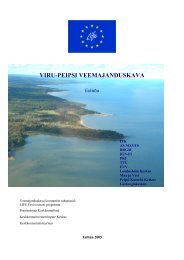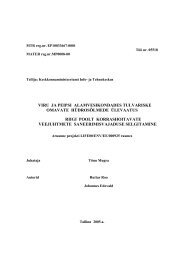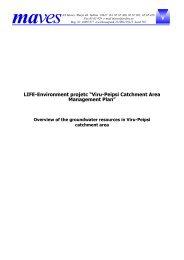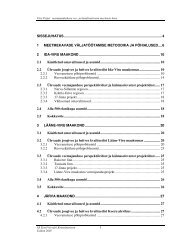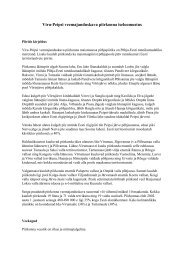Viru-Peipsi veemajanduskava - Keskkonnaministeerium
Viru-Peipsi veemajanduskava - Keskkonnaministeerium
Viru-Peipsi veemajanduskava - Keskkonnaministeerium
You also want an ePaper? Increase the reach of your titles
YUMPU automatically turns print PDFs into web optimized ePapers that Google loves.
3.2.3 Jõgede ökoloogilist seisundit määravad tegurid<br />
47<br />
3.2.3 Factors Determining Ecological Status of Rivers<br />
3.2.3 Jõgede ökoloogilist seisundit<br />
määravad tegurid<br />
3.2.3 Factors Determining Ecological<br />
Status of Rivers<br />
Jõgede ökoloogilise seisundi hindamisel arvestati<br />
veekvaliteeti (keemilist seisundit), põhjaloomastiku<br />
ning kalastiku uuringute andmeid ja jõgede hüdromorfolooglist<br />
seisundit, s.o jõesängi iseloomu ja<br />
tõkestatust (paisude olemasolu).<br />
Vastavalt EL veekogude ökoloogilise seisundi hindamise<br />
juhendile peab hea või väga hea ökoloogilise<br />
seisundi hinnangu saamiseks jõe keemiline<br />
seisund olema vähemalt hea. Seega langesid hea<br />
ökoloogilise seisundiga jõgede hulgast välja rahuldava<br />
ja halva keemilise seisundiga jõed ja jõelõigud.<br />
Põhjaloomastiku (Briti ASPT indeks) järgi on enamik<br />
piirkonna jõgesid heas või väga heas seisundis.<br />
Emajõgi ja osad sinna suubuvate jõgede<br />
suudmealad (Elva, Porijõgi, Ahja) kuuluvad ASPT<br />
indeksi järgi rahuldavasse seisundisse, kuid loodusliku<br />
eripära tõttu ei ole ASPT indeks Emajõe<br />
puhul „üks-üheselt“ rakendatav. Halvas seisundis<br />
olid põhjaloomastiku andmetel vaid Pühajõgi ja<br />
Kohtla jõgi. Siinjuures tuleks märkida, et põhjaloomastik<br />
ei iseloomusta alati jõe veekvaliteeti. Juhul<br />
kui jõesängi iseloom on hea ja hapnikku piisavalt<br />
ning toksilisi aineid ei esine, võib kõrge fosfori- ja<br />
lämmastikusisalduse tõttu halba keemilisse seisundisse<br />
hinnatud jõgi põhjaloomastiku järgi kuuluda<br />
väga heasse klassi (näiteks Selja jõe alamjooks).<br />
Kokkuvõtteks võib öelda, et mitte ühegi jõe puhul<br />
ei olnud ainult põhjaloomastik rahuldava või<br />
halva ökoloogilise seisundi hinnangu põhjuseks.<br />
Küll aga andis põhjaloomastiku hea või väga hea<br />
seisund kinnitust jõgede heasse ökoloogilisse klassi<br />
määramisel.<br />
Jõgede kalastiku seisundi määravad neli põhikomponenti:<br />
1) veekogu füüsiline kvaliteet (eelkõige elupaikade<br />
ˆ<br />
mitmekesisus);<br />
2) veekogu hüdroloogiline reziim (eelkõige<br />
jõe piisavalt suur miinimumvooluhulk);<br />
3) veekogu vee kvaliteet (eelkõige orgaanilise<br />
reostuse puudumine ning kaladele vastuvõetav<br />
ˆ<br />
hapnikureziim);<br />
The water quality (chemical status), data from the<br />
studies of macroinvertebrates and the fish fauna<br />
and the hydromorphological status, i.e. the structure<br />
of the riverbed and the transverse blocking<br />
of the river channel (dams) were taken into account<br />
for the assessment of the ecological status<br />
of rivers.<br />
In accordance with the EU Guidelines for the<br />
Classification of the Ecological Status of water<br />
bodies, in order to classify the ecological status<br />
good or very good the chemical status of a river<br />
has to be at least good. Consequently, the rivers<br />
or stretches of rivers of moderate or bad chemical<br />
status were excluded from the rivers of good<br />
ecological status.<br />
Data on macroinvertebrates (British ASPT index)<br />
indicate that the status of the most rivers in the<br />
region is good or very good. The Emajõgi River and<br />
the river mouths of some tributaries flowing into it<br />
(Elva, Porijõgi, Ahja rivers) have been classified<br />
moderate on the basis of ASPT index, but due to<br />
the specific natural features of the Emajõgi River<br />
the ASPT index is not strictly applicable. Only the<br />
status of the Pühajõgi and Kohtla rivers was bad<br />
on the basis of data on macroinvertebrates. It<br />
should be stressed that the macroinvertebrates do<br />
not always characterise the quality of the river<br />
water. In case the structure of the riverbed is<br />
good, the oxygen content adequate and the toxic<br />
substances non-existent, the river of bad chemical<br />
status due to the high phosphorus and nitrogen<br />
content may belong to the high status class on the<br />
basis of data on macroinvertebrates (e.g. the lower<br />
course of the Seljajõgi River). Consequently, the<br />
macroinvertebrates were not the reason for the<br />
classification of the ecological status as moderate<br />
or bad. However, the good or very good status of<br />
macroinvertebrates served to confirm the classification<br />
of rivers into good or very good ecological<br />
status class.<br />
The status of fish fauna can be determined by<br />
four components:<br />
1) the physical quality of a water body<br />
(primarily the diversity of habitats);<br />
2) the hydrological regime of a water body



